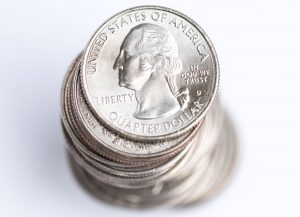
The pace of producing U.S. coins for circulation increased for a second straight month in February, manufacturing figures from the United States Mint show. The Mint also struck over a billion coins for the twelfth time in thirteen months.
U.S. Mint production facilities made just over 1.26 billion coins last month — spread across cents, nickels, dimes and quarters, marking increases of 0.8% from January and 8.3% from February of last year.
Here’s how the month compares against others in the past year:
February 2021 to February 2022 Circulating Coin Production
| Month | Mintages | Rank |
|---|---|---|
| February 2022 | 1,260.12 M | 5 |
| January 2022 | 1,249.84 M | 6 |
| December 2021 | 953.37 M | 13 |
| November 2021 | 1,104.7 M | 12 |
| October 2021 | 1,213.86 M | 7 |
| September 2021 | 1,169.28 M | 9 |
| August 2021 | 1,187.32 M | 8 |
| July 2021 | 1,505.24 M | 1 |
| June 2021 | 1,348.60 M | 3 |
| May 2021 | 1,473.06 M | 2 |
| April 2021 | 1,320.28 M | 4 |
| March 2021 | 1,134.84 M | 11 |
| February 2021 | 1,163.40 M | 10 |
The U.S. Mint’s main mission is to manufacture coins, based on the nation’s demand, and transport them to Reserve Banks and their coin terminals for distribution into circulation.
The Federal Reserve orders more 1-cent coins from the U.S. Mint than any other denomination even as data shows that it costs 2.1 cents to make and distribute each one. The Mint struck 694 million Lincoln cents last month, representing 55.1% of the circulating-quality coins produced last month.
Month-Over-Month
In month-over month comparisons for coins used daily by Americans, production totals in February saw:
- 7.2% fewer Lincoln cents,
- 23% more Jefferson nickels,
- 15.8% more Roosevelt dimes, and
- 6% more quarters.
Native American $1 coins are no longer ordered by the Federal Reserve, but they are still made in circulating quality for coin collectors. The same is true, or was until last year, for Kennedy half-dollars. Traditionally in January, the U.S. Mint produces both denominations to the expected amounts needed for the entire year. That turned true in 2021 for Native American dollars, but not for halves which saw their mintage last year increase in February, March, April, May and August.
Published mintages of 2022 Native American dollars were unchanged in February, with equal splits of 980,000 from Denver and 980,000 from Philadelphia for a combined 1.96 million coins. In contrast, the 2021 dollar logged splits of 1.26 million for Denver and 1.26 million for Philadelphia for 2.52 million coins.
Mintages for the 2022 Kennedy half-dollar also remained unchanged from January. They stand at 1.6 million from Denver and 1.6 million from Philadelphia for a total of 3.2 million. Last year’s half-dollar ended with a mix of 7.7 million from Denver and 5.4 million from Philadelphia for a combined 13.1 million.
The U.S. Mint started selling rolls, bags and boxes of 2022 Native American dollars on Feb. 9. Rolls and bags of 2022 Kennedy halves are scheduled for release on May 5.
Here’s a summary of all the circulating-quality coins produced last month:
U.S. Mint Circulating Coin Production in February 2022
| Denver | Philadelphia | Total | |
|---|---|---|---|
| Lincoln Cent | 356,400,000 | 337,600,000 | 694,000,000 |
| Jefferson Nickel | 73,920,000 | 68,400,000 | 142,320,000 |
| Roosevelt Dime | 120,000,000 | 114,000,000 | 234,000,000 |
| Quarters | 97,800,000 | 92,000,000 | 189,800,000 |
| Kennedy Half-Dollar | 0 | 0 | 0 |
| Native American $1 Coin | 0 | 0 | 0 |
| Total | 648,120,000 | 612,000,000 | 1,260,120,000 |
Minting facilities in Philadelphia and Denver are tasked with making all U.S. coins for commerce. Last month, the Denver Mint made 684.12 million coins and the Philadelphia Mint made 612 million coins for the combined 1,260,120,000 coins.
Meanwhile, in the January to February period, the Denver Mint struck 1,319,720,000 coins and the Philadelphia Mint made 1,190,240,000 coins. They combine for a year-to-date total of 2,509,960,000 coins, which is 20.5% more than the 2,082,920,000 coins minted in the first two months of last year.
This next table lists coin production totals by denomination and by U.S. Mint facility:
YTD 2022 Circulating Coin Production by Denomination
| 1 ¢ | 5 ¢ | 10 ¢ | 25 ¢ | 50 ¢ | N.A. $1 | Total: | |
|---|---|---|---|---|---|---|---|
| Denver | 762.8M | 135.84M | 225.5M | 193M | 1.6M | .98M | 1319.72M |
| Philadelphia | 679.2M | 122.16M | 210.5M | 175.8M | 1.6M | .98M | 1190.24M |
| Total | 1442M | 258M | 436M | 368.8M | 3.2M | 1.96M | 2509.96M |
If the current production pace stretched through to December, the annual mintage for 2022 would top 15 billion coins. The U.S. Mint manufactured nearly 14.5 billion coins for circulation in 2021.
Lastly, in addition to the Native American dollar, the U.S. Mint through February released another coin with a one-year-only design and that is the first issue from their four-year program of American Women Quarters™. 2022 Maya Angelou quarters started circulating in January. (The Mint started selling collectible Maya Angelou quarters in rolls and bags on Feb. 7.) The circulating quarter figures above probably include all of them, as well as a portion of the program’s second coin, quarters featuring Dr. Ride Sally which launched into circulation in March.





